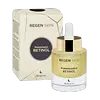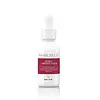What's inside
What's inside
 Key Ingredients
Key Ingredients

 Benefits
Benefits

 Concerns
Concerns

 Ingredients Side-by-side
Ingredients Side-by-side

Water
Skin ConditioningOlive Oil PEG-8 Esters
EmollientPropanediol
SolventPEG-8 Caprylic/Capric Glycerides
EmulsifyingPropylene Glycol
HumectantBakuchiol
AntimicrobialPolysorbate 20
EmulsifyingRetinol
Skin ConditioningRetinyl Palmitate
Skin ConditioningTocopheryl Acetate
AntioxidantTocopherol
AntioxidantOligopeptide-1
Skin ConditioningButylene Glycol
HumectantPolyacrylate Crosspolymer-6
Emulsion StabilisingCopernicia Cerifera Cera
EmollientXanthan Gum
EmulsifyingGlycerin
HumectantParfum
MaskingSodium Cocoamphoacetate
Cleansing1,2-Hexanediol
Skin ConditioningCaprylyl Glycol
EmollientBHT
AntioxidantBHA
AntioxidantCitric Acid
BufferingTetrasodium Glutamate Diacetate
T-Butyl Alcohol
PerfumingWater, Olive Oil PEG-8 Esters, Propanediol, PEG-8 Caprylic/Capric Glycerides, Propylene Glycol, Bakuchiol, Polysorbate 20, Retinol, Retinyl Palmitate, Tocopheryl Acetate, Tocopherol, Oligopeptide-1, Butylene Glycol, Polyacrylate Crosspolymer-6, Copernicia Cerifera Cera, Xanthan Gum, Glycerin, Parfum, Sodium Cocoamphoacetate, 1,2-Hexanediol, Caprylyl Glycol, BHT, BHA, Citric Acid, Tetrasodium Glutamate Diacetate, T-Butyl Alcohol
Water
Skin ConditioningDimethicone
EmollientPropanediol
SolventGlycerin
HumectantRetinol
Skin ConditioningCaprylic/Capric Triglyceride
MaskingBakuchiol
AntimicrobialVaccinium Macrocarpon Fruit Extract
AstringentLactobacillus Ferment
Skin ConditioningTocopherol
Antioxidant1,2-Hexanediol
Skin ConditioningHumulus Lupulus Extract
AntimicrobialDimethiconol
EmollientPolyacrylate Crosspolymer-6
Emulsion StabilisingMaltodextrin
AbsorbentHydroxyethyl Acrylate/Sodium Acryloyldimethyl Taurate Copolymer
Emulsion StabilisingPotassium Sorbate
PreservativeSqualane
EmollientSodium Gluconate
Skin ConditioningCaprylhydroxamic Acid
Copernicia Cerifera Cera
EmollientCitric Acid
BufferingPolysorbate 20
EmulsifyingPolysorbate 60
EmulsifyingHelianthus Annuus Seed Oil
EmollientCaprylyl Glycol
EmollientHydroxymethoxyphenyl Decanone
Skin ConditioningDisodium Cocoamphodiacetate
CleansingC13-16 Isoalkane
SolventT-Butyl Alcohol
PerfumingXanthan Gum
EmulsifyingEthyl Ferulate
AntioxidantWater, Dimethicone, Propanediol, Glycerin, Retinol, Caprylic/Capric Triglyceride, Bakuchiol, Vaccinium Macrocarpon Fruit Extract, Lactobacillus Ferment, Tocopherol, 1,2-Hexanediol, Humulus Lupulus Extract, Dimethiconol, Polyacrylate Crosspolymer-6, Maltodextrin, Hydroxyethyl Acrylate/Sodium Acryloyldimethyl Taurate Copolymer, Potassium Sorbate, Squalane, Sodium Gluconate, Caprylhydroxamic Acid, Copernicia Cerifera Cera, Citric Acid, Polysorbate 20, Polysorbate 60, Helianthus Annuus Seed Oil, Caprylyl Glycol, Hydroxymethoxyphenyl Decanone, Disodium Cocoamphodiacetate, C13-16 Isoalkane, T-Butyl Alcohol, Xanthan Gum, Ethyl Ferulate
Ingredients Explained
These ingredients are found in both products.
Ingredients higher up in an ingredient list are typically present in a larger amount.
1,2-Hexanediol is a synthetic liquid and another multi-functional powerhouse.
It is a:
- Humectant, drawing moisture into the skin
- Emollient, helping to soften skin
- Solvent, dispersing and stabilizing formulas
- Preservative booster, enhancing the antimicrobial activity of other preservatives
Bakuchiol is a plant-derived antioxidant (it's vegan!). It is often called the replacement for retinol although it is not part of the same family.
It has similar effects as retinol: skin smoothing, reducing discoloration, and preventing wrinkles. It does not cause as much irritation as traditional retinoids.
Bakuchiol works by breaking down free radicals and stimulating collagen production in skin.
Combining bakuchiol with retinol will not have adverse side effects. Studies show using them will just boost the benefits. Bakuchiol is also found to help stabilize retinol.
While bakuchiol does not make the skin more sun sensitive, we recommend wearing SPF on a daily basis.
Read more about traditional retinol
Learn more about BakuchiolCaprylyl Glycol is a humectant and emollient, meaning it attracts and preserves moisture.
It is a common ingredient in many products, especially those designed to hydrate skin. The primary benefits are retaining moisture, skin softening, and promoting a healthy skin barrier.
Though Caprylyl Glycol is an alcohol derived from fatty acids, it is not the kind that can dry out skin.
This ingredient is also used as a preservative to extend the life of products. It has slight antimicrobial properties.
Learn more about Caprylyl GlycolCitric Acid is an alpha hydroxy acid (AHA) naturally found in citrus fruits like oranges, lemons, and limes.
Like other AHAs, citric acid can exfoliate skin by breaking down the bonds that hold dead skin cells together. This helps reveal smoother and brighter skin underneath.
However, this exfoliating effect only happens at high concentrations (20%) which can be hard to find in cosmetic products.
Due to this, citric acid is usually included in small amounts as a pH adjuster. This helps keep products slightly more acidic and compatible with skin's natural pH.
In skincare formulas, citric acid can:
While it can provide some skin benefits, research shows lactic acid and glycolic acid are generally more effective and less irritating exfoliants.
Most citric acid used in skincare today is made by fermenting sugars (usually from molasses). This synthetic version is identical to the natural citrus form but easier to stabilize and use in formulations.
Read more about some other popular AHA's here:
Learn more about Citric AcidThis ingredient comes from a palm tree native to Brazil. This ingredient is used to thicken texture and leaves behind a film when applied.
Glycerin is already naturally found in your skin. It helps moisturize and protect your skin.
A study from 2016 found glycerin to be more effective as a humectant than AHAs and hyaluronic acid.
As a humectant, it helps the skin stay hydrated by pulling moisture to your skin. The low molecular weight of glycerin allows it to pull moisture into the deeper layers of your skin.
Hydrated skin improves your skin barrier; Your skin barrier helps protect against irritants and bacteria.
Glycerin has also been found to have antimicrobial and antiviral properties. Due to these properties, glycerin is often used in wound and burn treatments.
In cosmetics, glycerin is usually derived from plants such as soybean or palm. However, it can also be sourced from animals, such as tallow or animal fat.
This ingredient is organic, colorless, odorless, and non-toxic.
Glycerin is the name for this ingredient in American English. British English uses Glycerol/Glycerine.
Learn more about GlycerinPolyacrylate Crosspolymer-6 is a texture enhancer and pH adjuster.
It is be used to thicken water-based products and create a gel-texture with a velvet feel.
One manufacturer claims this ingredient to have a pH range of 2-8 and to be biodegradable.
Learn more about Polyacrylate Crosspolymer-6Polysorbate 20 is made by combining ethoxylation of sorbitan, ethylene oxide, and lauric acid. It is a mild cleansing agent, surfactant, and emulsifier.
As a surfactant, it helps collect dirt and oils for washing. Emulsifiers prevent oils and water from separating.
Polysorbate 20 also adds scent to a product. Since it is made using sorbitol, it has a sweet scent. Sorbitol can also be found in fruits such as apples and peaches.
The lauric acid used to create Polysorbate 20 is often derived from coconuts.
Polysorbate 20 may not be fungal acne safe.
Learn more about Polysorbate 20Propanediol is an all-star ingredient. It softens, hydrates, and smooths the skin.
It’s often used to:
Propanediol is not likely to cause sensitivity and considered safe to use. It is derived from corn or petroleum with a clear color and no scent.
Learn more about PropanediolRetinol is a gold-standard ingredient for anti-aging. It is a form of Vitamin A and belongs to the class of retinoids that also includes tretinoin.
Why is retinol famous?
It has the most scientific studies backing up its skin benefits out of all the non-prescription ingredients.
Retinol is proven to:
This is why retinol is effective at removing wrinkles, fading dark spots, treating acne, and reducing the appearance of pores.
Studies show retinol is less effective when exposed to UV. Be sure to look for appropriate packaging to keep your retinol potent (similar to Vitamin C).
Using retinol or any retinoids will increase sun-sensitivity in the first few months. Though studies show retinoids increase your skin's natural SPF with continuous use, it is best to always wear sunscreen and sun-protection.
We recommend speaking with a medical professional about using this ingredient during pregnancy.
Retinol may cause irritation in some people, so be sure to patch test. Experts recommend 'ramping up' retinol use: start using this ingredient once a week and work up to using it daily.
Read about Tretinoin
Learn more about RetinolT-Butyl Alcohol it is most commonly used as a solvent.
At room temperature, T-Butyl Alcohol melts and has a similar smell to camphor.
This ingredient is derived from isobutane. It is the simplest form of a tertiary alcohol. Due to its chemical structure, it is more resistant to oxidation.
Some sources online claim T-Butyl Alcohol is a fatty alcohol. However, it is not considered one due to its chemical structure.
Learn more about T-Butyl AlcoholTocopherol (also known as Vitamin E) is a common antioxidant used to help protect the skin from free-radicals and strengthen the skin barrier. It's also fat soluble - this means our skin is great at absorbing it.
Vitamin E also helps keep your natural skin lipids healthy. Your lipid skin barrier naturally consists of lipids, ceramides, and fatty acids. Vitamin E offers extra protection for your skin’s lipid barrier, keeping your skin healthy and nourished.
Another benefit is a bit of UV protection. Vitamin E helps reduce the damage caused by UVB rays. (It should not replace your sunscreen). Combining it with Vitamin C can decrease sunburned cells and hyperpigmentation after UV exposure.
You might have noticed Vitamin E + C often paired together. This is because it is great at stabilizing Vitamin C. Using the two together helps increase the effectiveness of both ingredients.
There are often claims that Vitamin E can reduce/prevent scarring, but these claims haven't been confirmed by scientific research.
Learn more about TocopherolWater. It's the most common cosmetic ingredient of all. You'll usually see it at the top of ingredient lists, meaning that it makes up the largest part of the product.
So why is it so popular? Water most often acts as a solvent - this means that it helps dissolve other ingredients into the formulation.
You'll also recognize water as that liquid we all need to stay alive. If you see this, drink a glass of water. Stay hydrated!
Learn more about WaterXanthan gum is used as a stabilizer and thickener within cosmetic products. It helps give products a sticky, thick feeling - preventing them from being too runny.
On the technical side of things, xanthan gum is a polysaccharide - a combination consisting of multiple sugar molecules bonded together.
Xanthan gum is a pretty common and great ingredient. It is a natural, non-toxic, non-irritating ingredient that is also commonly used in food products.
Learn more about Xanthan Gum